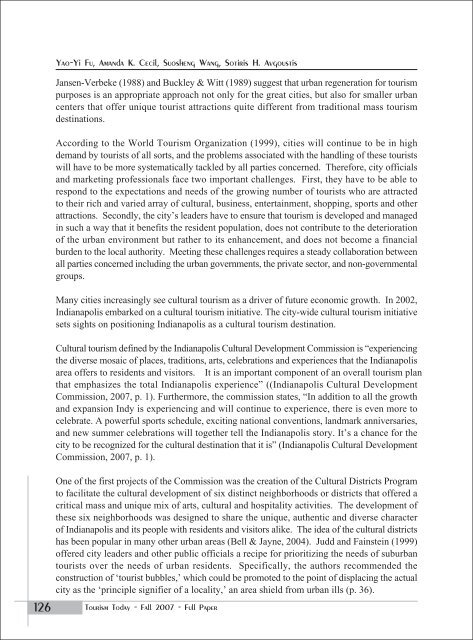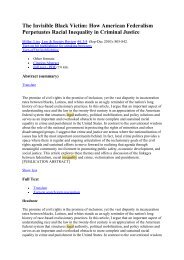Ski – resort and regional development: profile of visitors ... - E-Journal
Ski – resort and regional development: profile of visitors ... - E-Journal
Ski – resort and regional development: profile of visitors ... - E-Journal
Create successful ePaper yourself
Turn your PDF publications into a flip-book with our unique Google optimized e-Paper software.
126<br />
Yao-Yi Fu, Am<strong>and</strong>a K. Cecil, Suosheng Wang, Sotiris H. Avgoustis<br />
Jansen-Verbeke (1988) <strong>and</strong> Buckley & Witt (1989) suggest that urban regeneration for tourism<br />
purposes is an appropriate approach not only for the great cities, but also for smaller urban<br />
centers that <strong>of</strong>fer unique tourist attractions quite different from traditional mass tourism<br />
destinations.<br />
According to the World Tourism Organization (1999), cities will continue to be in high<br />
dem<strong>and</strong> by tourists <strong>of</strong> all sorts, <strong>and</strong> the problems associated with the h<strong>and</strong>ling <strong>of</strong> these tourists<br />
will have to be more systematically tackled by all parties concerned. Therefore, city <strong>of</strong>ficials<br />
<strong>and</strong> marketing pr<strong>of</strong>essionals face two important challenges. First, they have to be able to<br />
respond to the expectations <strong>and</strong> needs <strong>of</strong> the growing number <strong>of</strong> tourists who are attracted<br />
to their rich <strong>and</strong> varied array <strong>of</strong> cultural, business, entertainment, shopping, sports <strong>and</strong> other<br />
attractions. Secondly, the city’s leaders have to ensure that tourism is developed <strong>and</strong> managed<br />
in such a way that it benefits the resident population, does not contribute to the deterioration<br />
<strong>of</strong> the urban environment but rather to its enhancement, <strong>and</strong> does not become a financial<br />
burden to the local authority. Meeting these challenges requires a steady collaboration between<br />
all parties concerned including the urban governments, the private sector, <strong>and</strong> non-governmental<br />
groups.<br />
Many cities increasingly see cultural tourism as a driver <strong>of</strong> future economic growth. In 2002,<br />
Indianapolis embarked on a cultural tourism initiative. The city-wide cultural tourism initiative<br />
sets sights on positioning Indianapolis as a cultural tourism destination.<br />
Cultural tourism defined by the Indianapolis Cultural Development Commission is “experiencing<br />
the diverse mosaic <strong>of</strong> places, traditions, arts, celebrations <strong>and</strong> experiences that the Indianapolis<br />
area <strong>of</strong>fers to residents <strong>and</strong> <strong>visitors</strong>. It is an important component <strong>of</strong> an overall tourism plan<br />
that emphasizes the total Indianapolis experience” ((Indianapolis Cultural Development<br />
Commission, 2007, p. 1). Furthermore, the commission states, “In addition to all the growth<br />
<strong>and</strong> expansion Indy is experiencing <strong>and</strong> will continue to experience, there is even more to<br />
celebrate. A powerful sports schedule, exciting national conventions, l<strong>and</strong>mark anniversaries,<br />
<strong>and</strong> new summer celebrations will together tell the Indianapolis story. It’s a chance for the<br />
city to be recognized for the cultural destination that it is” (Indianapolis Cultural Development<br />
Commission, 2007, p. 1).<br />
One <strong>of</strong> the first projects <strong>of</strong> the Commission was the creation <strong>of</strong> the Cultural Districts Program<br />
to facilitate the cultural <strong>development</strong> <strong>of</strong> six distinct neighborhoods or districts that <strong>of</strong>fered a<br />
critical mass <strong>and</strong> unique mix <strong>of</strong> arts, cultural <strong>and</strong> hospitality activities. The <strong>development</strong> <strong>of</strong><br />
these six neighborhoods was designed to share the unique, authentic <strong>and</strong> diverse character<br />
<strong>of</strong> Indianapolis <strong>and</strong> its people with residents <strong>and</strong> <strong>visitors</strong> alike. The idea <strong>of</strong> the cultural districts<br />
has been popular in many other urban areas (Bell & Jayne, 2004). Judd <strong>and</strong> Fainstein (1999)<br />
<strong>of</strong>fered city leaders <strong>and</strong> other public <strong>of</strong>ficials a recipe for prioritizing the needs <strong>of</strong> suburban<br />
tourists over the needs <strong>of</strong> urban residents. Specifically, the authors recommended the<br />
construction <strong>of</strong> ‘tourist bubbles,’ which could be promoted to the point <strong>of</strong> displacing the actual<br />
city as the ‘principle signifier <strong>of</strong> a locality,’ an area shield from urban ills (p. 36).<br />
Tourism Today - Fall 2007 - Full Paper














